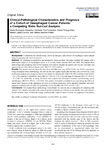Clinical-pathological characteristics and prognosis of a cohort of oesophageal cancer patients: a competing risks survival analysis

Use this link to cite
http://hdl.handle.net/2183/30932Collections
- Investigación (FCS) [1293]
Metadata
Show full item recordTitle
Clinical-pathological characteristics and prognosis of a cohort of oesophageal cancer patients: a competing risks survival analysisAuthor(s)
Date
2015-01-19Citation
Rodríguez-Camacho E, Pita-Fernández S, Pértega-Díaz S, López-Calviño B, Seoane-Pillado T. Clinical-pathological characteristics and prognosis of a cohort of oesophageal cancer patients: a competing risks survival analysis. J Epidemiol. 2015;25(3):231-8. doi: 10.2188/jea.JE20140118. Epub 2015 Jan 19. PMID: 25716135; PMCID: PMC4341000.
Abstract
[Abstract] Background: To determine the clinical course, follow-up strategies, and survival of oesophageal cancer patients using a competing risks survival analysis.
Methods: We conducted a retrospective and prospective follow-up study. The study included 180 patients with a pathological diagnosis of oesophageal cancer in A Coruña, Spain, between 2003 and 2008. The Kaplan-Meier methodology and competing risks survival analysis were used to calculate the specific survival rate. The study was approved by the Ethics Review Board (code 2011/372, CEIC Galicia).
Results: The specific survival rate at the first, third, and fifth years was 40.2%, 18.1%, and 12.4%, respectively. Using the Kaplan-Meier methodology, the survival rate was slightly higher after the third year of follow-up. In the multivariate analysis, poor prognosis factors were female sex (hazard ratio [HR] 1.94; 95% confidence interval [CI], 1.24-3.03), Charlson's comorbidity index (HR 1.17; 95% CI, 1.02-1.33), and stage IV tumours (HR 1.70; 95% CI, 1.11-2.59). The probability of dying decreased with surgical and oncological treatment (chemotherapy and/or radiotherapy) (HR 0.23; 95% CI, 0.12-0.45). The number of hospital consultations per year during the follow-up period, from diagnosis to the appearance of a new event (local recurrences, newly appeared metastasis, and newly appeared neoplasias) did not affect the probability of survival (HR 1.03; 95% CI, 0.92-1.15).
Conclusions: The Kaplan-Meier methodology overestimates the survival rate in comparison to competing risks analysis. The variables associated with a poor prognosis are female sex, Charlson's comorbidity score and extensive tumour invasion. Type of follow-up strategy employed after diagnosis does not affect the prognosis of the disease.
Keywords
Oesophageal neoplasms
Therapeutics
Survival
Follow-up studies
Therapeutics
Survival
Follow-up studies
Editor version
Rights
Atribución 3.0 España
ISSN
0917-5040






